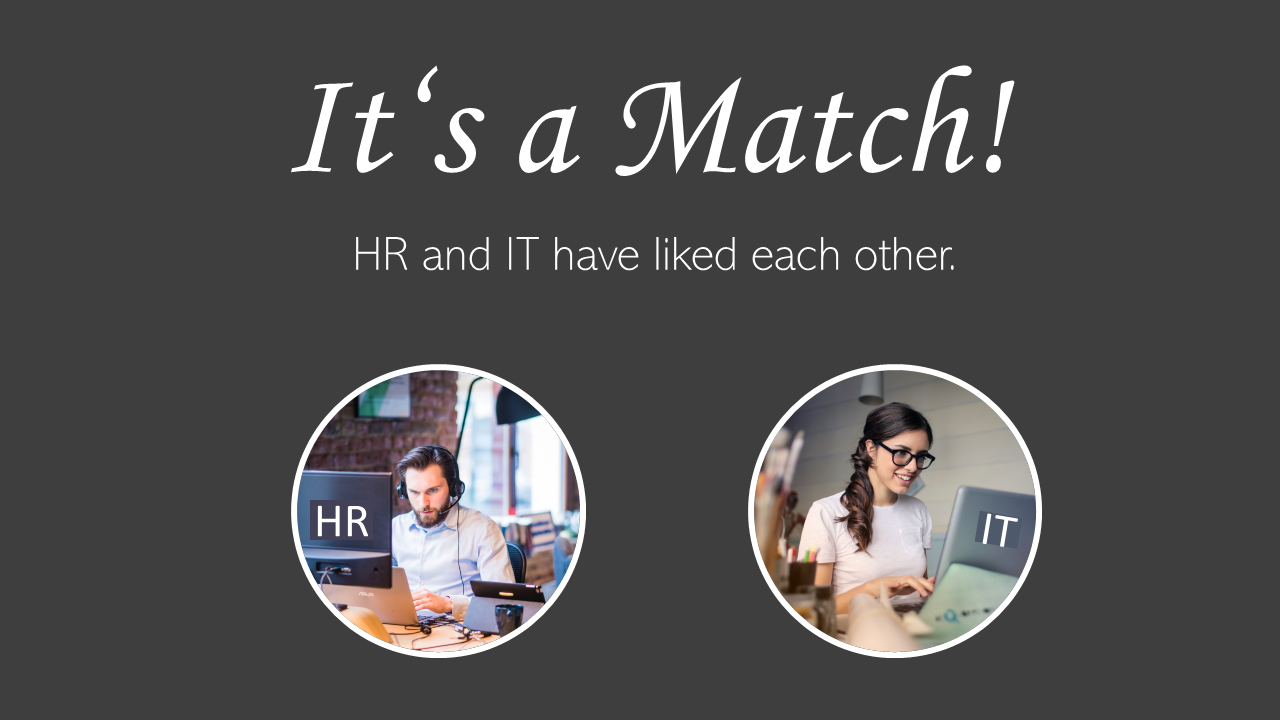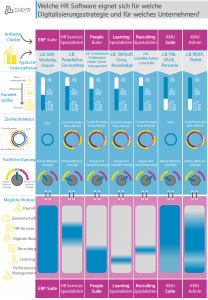Not every HR IT architecture suits every company. Find out which HR digitization strategy is right for you.

In our HR digitization strategy overview, we show:
It’s a Match! – how HR and IT Come Together
For years, the HR and IT departments have been as far apart as possible. There is rarely an HR digitization strategy. Some take care of technology; others care about people. However; in recent years, the two departments have come ever closer together and there is an increasing demand for holistic HR IT architectures. Digital HR requires the right HR software and thus forces HR and IT to work together.

HR Software Comparison
We will find the right HR software for you!
There are a variety of software providers in the HR Sector.
From the all-encompassing suite to the modular People-Management Software to the specialist.
We will show you which HR IT architecture is suitable for each.
HR Digitization Strategy: Business Impact through Digital People Management
“Crunch time” for HR! It probably doesn’t take any steep templates to really push (HR) digitization forward and to develop an HR digitization strategy:
- Covid-19 is forcing end-to-end digitization of HR core processes.
- Digitization still requires the ability to rapidly and massively develop the workforce.
- Transformations into new business models with completely new value chains put the employees and their support of the transformation back into focus.
If you want to keep up with the market, you don’t only need modified cultural framework conditions but also powerful and agile IT options in recruiting and people development. It’s about technical innovation and digital tools, IT systems adapted to the company and user-friendly interfaces.
It’s about…
…to optimize career pages and job advertisements and to make the application process fast and innovative
…retaining and developing talent with individual development and coaching
…to control and support the performance of the employees depending on the situation
…driving analyzes and making predictions
As far as is well known; however, it is still unclear in some circles of decision-makers what these changed requirements for HR (IT) management and HR IT architecture mean in order to digitally map these new essential HR services.
What We are Proud of:
Already reached over 1200 projects and therefore, over 6 million
employees in 80 countries.
Do you just Admin or are You already Developing your Workforce?
First of all: it’s not about being a pioneer in every new market trend, it’s about using suitable market trends to become a pioneer in your own HR work.
So far, HR digitization has been more in the sense of digital administration. After all, this is an efficient business case that management quickly grasps. Efficiency and costs were key arguments when choosing HR software.
But welcome to the new entrepreneurial reality in a disruptive market environment! The rules of the game are different here. Both HR administration and the topics of strategic people development must be the focus when selecting HR software. And therein lies the difficulty in implementing such an HR-IT architecture.
The HR software market is large and confusing. The providers are pursuing different strategies. There are “generalists” in the ERP environment (you probably know at least two?) who offer so-called suites. They aim to cover the entire range of HR processes and functions.
Other providers, e.g. in the context of talent management, try to bundle thematically related module clusters into one software. And then there are specialists who offer software for a specific HR core process.
Who is the best Fit for Your Company?
As a rule of thumb, the following applies: “The broader a software’s range of covered modules is, the more difficult it is for the provider to remain equally innovative in the functions across all modules and to map the requirements of the users.”
That means you have to ask yourself the following questions: what do you want – a generalist or a specialist? Administration or Development?
In addition, the provider history of the software provider is usually also an indication of the thematic further development of the software. The professional origin of the provider usually manifests itself in a kind of “supplier DNA” (focus more on administrative HR management or personnel development).
Tip: Where providers are on the move with an independent, innovative approach to topics that are more focused on people development, they often offer more basic functions for administrative topics – and vice versa!
“ONE ERP” vs. Best of Breed – the Big Question of the HR Digitization Strategy
A highly developed workforce requires an agile, innovative HR IT environment. In the future, powerful HR IT architectures will be characterized by the ability to use the most suitable HR software for the respective purpose.
Tip: The following applies: the more heterogeneous the future workforce will be and the more organizational agility is expected, the less suitable the classic “One ERP” strategy will be.
Arguments such as “holistic license management” and the supposed standard integration of the systems only really apply to individual ERP providers anyway. Even years later, purchased modules are too often neither visually nor technically integrated via interfaces for the end user.
Hybrid sourcing models, i.e. the mix of different applications, as well as the modernization of the IT landscape through microservices and APIs are increasingly being demanded by customers and developed by providers. SaaS solutions are increasingly recognizing that not all requirements can be met by one solution and are therefore offering more and more options for exporting and importing data and are increasingly moving towards web services, marketplaces and third-party integrations.
Systems can communicate faster and better with each other. By using the available technologies, many advantages of the various providers can be optimally used. In this way, processes can be mapped in the best possible systems and the necessary data can also be easily transferred between the providers. What is the right amount of interfaces depends heavily on the current landscape but also on the requirements for future processes and integrations.
Tip: The use of middleware or a data warehouse can be helpful, as it harmonizes the data from different sources and independently recognizes errors and problems of an interface and can also solve them upon necessary.
Performance as the Top Priority of HR and the HR Digitization Strategy
The performance of the employees is therefore the success factor of digital HR. Your HR digitization strategy should have it as the top priority. It must be consistently secured and increased. For the future workforce, the excellence of the HR IT infrastructure, which on the one hand controls their own further development, and also organizes administrative matters, is a matter of course and a question of appreciation.
The aim of an HR digitization strategy should be a stable, future-proof and secure HR IT architecture that can meet all the requirements of the specialist processes. With more and more possibilities, it is also becoming easier and easier to really master these challenges.
And when it comes to these common goals, HR and IT come together quite well after all?
The top 10 HR Digitization Strategy Terms Simply Explained!
Read more about HR digitization strategy and HR IT architecture and find relevant technical terms simply explained. Below you will also find suitable articles on the subject of HR digitization strategy.



